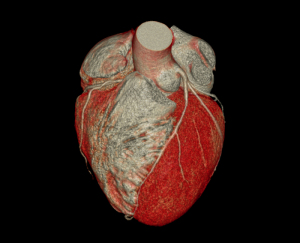by
John R. Fischer, Senior Reporter | August 28, 2018

A new approach could help patients
evade unnecessary, invasive heart
procedures
Researchers in Denmark have proposed a new approach that could spare patients with coronary artery disease from undergoing unnecessary and invasive diagnostic procedures.
Presenting their findings this month at ESC Congress 2018 in Munich, the investigators argued that utilizing fractional flow reserve computed tomography (FFRCT) rather than invasive operations like FFR can determine appropriate forms of treatment for patients. It is the first clinical study to show the benefits of FFRCT in patients with moderate stenosis.
"FFR is measured by inserting a pressure wire distal to the coronary stenosis of interest. Although generally a safe procedure, every instrumentation of the coronaries may be a risk - dissection, perforation, myocardial infaction, stroke, bleeding," Dr Bjarne Linde Nørgaard, principal investigator of Aarhus University Hospital in Denmark, told HCB News. "CT-FFR is based on standard acquired datasets (no extra imaging, radiation, medication), and thus is not associated with any additional risk."



Ad Statistics
Times Displayed: 1227
Times Visited: 6 Fast-moving cardiac structures have a big impact on imaging. Fujifilm’s SCENARIA View premium performance CT brings solutions to address motion in Coronary CTA while delivering unique dose saving and workflow increasing benefits.
Current practice requires patients to undergo noninvasive computed tomography angiography to determine the degree of stenosis, followed by an invasive FFR assessment to evaluate whether the stenosis is causing ischemia by blocking blood flow. FFR involves inserting a pressure wire into the artery to calculate the ratio between the maximum blood flow in narrow arteries and the maximum blood flow in normal ones.
Applying FFRCT to 3,674 patients with stable angina, researchers assessed ischaemia by calculating FRR using anatomic information from standard coronary CTA scans and an algorithm for simulating blood flow. All patients previously underwent coronary CTA after incurring new onset chest pain between 2014 and 2016.
The approach determined that 677 suffered from moderate stenosis, requiring FFRCT to oversee further management. Of this number, 410 were found to have normal FFRCT and were treated with drugs alone, requiring no referral for coronary angiography or other invasive testing.
A total of 2,540 patients had mild stenosis and received no additional testing while 0.80 percent or less were diagnosed with abnormal FFRCT and subjected to either medical therapy alone or invasive coronary angiography, depending on the number of affected arteries and their locations.
Researchers then evaluated the onset of a combined endpoint of all-cause death, myocardial infarction, hospitalization rates for unstable angina and unplanned revascularization between patients with mild stenosis on coronary CTA and those with moderate stenosis on coronary CTA but normal FFRCT, finding little difference between the two at 2.8 percent and 3.9 percent, respectively.

